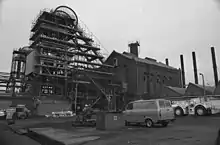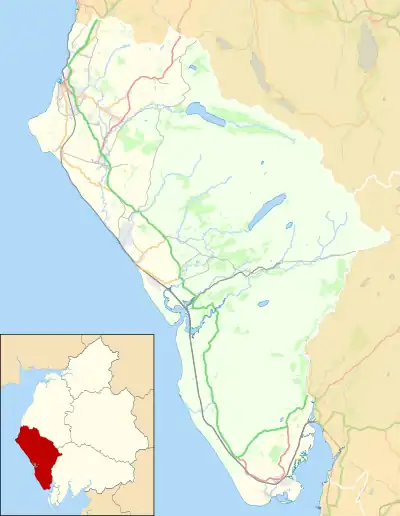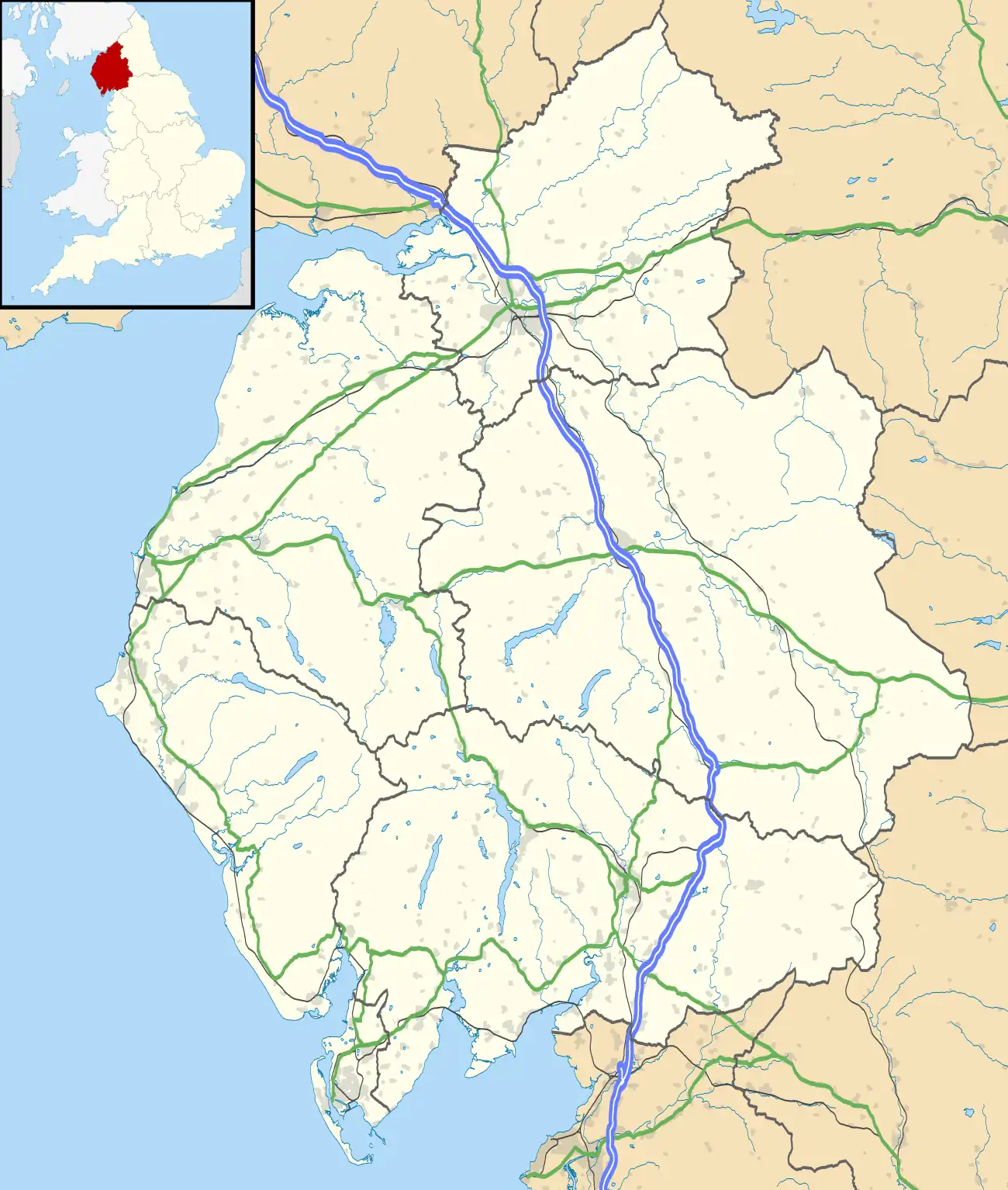 Haig Colliery in 1983 | |
| Location | |
|---|---|
 Haig Colliery Location in Copeland Borough  Haig Colliery Location in Cumbria | |
| Location | Whitehaven |
| Cumbria | |
| Country | England |
| Coordinates | 54°32′35″N 3°35′52″W / 54.542957°N 3.597768°W |
| Production | |
| Products | Coal (anthracite) |
| Production | 700,000 tonnes (690,000 long tons; 770,000 short tons) per year (average) |
| Type | Underground/under-sea |
| History | |
| Opened | 1916 |
| Closed | 1986 |
| Owner | |
| Company | Whitehaven Coal Company (on opening) British Coal (at closure) |
Haig Colliery was a coal mine in Whitehaven, Cumbria, in north-west England. The mine was in operation for almost 70 years and produced anthracitic coal which is most useful for coking coal. Situated on the coast, the underground workings of the mine spread westwards out under the Irish Sea and mining was undertaken at over 4 miles (6.4 km) out underneath the sea bed.
History
The mine was sunk in 1914[1] with production not starting until 1916, and full production not starting until 1925.[2] The mine was named after Douglas Haig, the First World War commander. This followed a typical pattern of naming pits after famous figures of the day in Cumbria (Ladysmith after the battle and Wellington after the former Prime Minister).[3]
The colliery was connected to Wellington Colliery in 1922 and the two mines worked in conjunction with each other until Wellington closed in 1932. Initially Haig was operated by the Bord and pillar method, with Longwall mining taking over from the late 1930s.[3]
Operations
The mine's first shaft was known as No. 4 as three other shafts had already been dug in the same area belonging to other mines located closer to Whitehaven Harbour.[4] Shaft No. 4 was 1,270 feet (387 m) deep and 19 feet (5.8 m) in diameter.[5] No. 5 shaft was constructed at the same time, but the winding gear and steam engine were not installed until 1920-1921[6] and its shaft was slightly wider at 22.2 feet (6.77 m) in diameter.[5] The engines powering both shafts were built by Bever Dorling of Bradford. Initially, No. 4 shaft was used to transport everything in and out of the mine, but when No. 5 shaft was fitted out, all coal came via that shaft with No. 4 being used for man-riding only.[1] The mine extended out across the Saltom Bay area of the Irish Sea for 4 miles (6.4 km).[7]
In the almost 70 years that Haig was in production, it brought 48,000,000 tonnes (47,000,000 long tons; 53,000,000 short tons) of coal to the surface. The winders were limited to 6 tonnes (5.9 long tons; 6.6 short tons) capacity, which meant that on average, the mine only produced 700,000 tonnes (690,000 long tons; 770,000 short tons) per annum.[3]
Accidents
The collieries around Whitehaven, and Haig in particular, were noted for their prevalence to Firedamp (Methane).[8] Between 1922 and 1931, 79 men died as a result of three explosions (in 1922, 1928 and 1931).[1]
The 5 September 1922 explosion was caused by a pocket of gas being ignited. The day before, gas had been reported in the Six Quarters Seam of the mine, and the deputy in charge, William Weightman, descended to assess the situation with a shot-firer. Weightman approved the shot-firer to go ahead and deploy his shot which ignited the gas in that area of the mine. Just before 9:00 am, the banksman of the mine noted a cloud of dust rising up No. 4 shaft and Mines rescue were called out. In all, 39 men died in the explosion with all bodies being recovered by 10 September. Identification of the bodies was difficult because of damage to the miners faces; one had to be identified by his belt and trousers because his face was so disfigured.[9]
An explosion occurred on 13 December 1927 which killed four men. On 9 February 1928, efforts were made to go in and check on the state of the mine, the 800 miners of the interconnected Wellington Mine had gone back to work on 3 January 1928, but the 1,100 miners at Haig were still unable to return to work. The check of the mine was also used as an effort to recover the body of Harold Horrocks who had not been recovered since the 13 December accident. A body of 24 men entered the mine to assess the damage and various trips back to the surface for sustenance and to re-fill breathing apparatus were undertaken throughout the day and night. Sometime after 11:00 pm, three explosions rocked the area, each more violent than the last. 11 survivors managed to navigate the 3 miles (4.8 km) in the dark to the bottom of the shafts where another rescue party was sent down the mine. The canaries that the rescue party carried with them soon died and when the second rescue party reached where the last explosion occurred they found the roof completely collapsed and extensive damage. As there was evidence of another fire, the area was sealed off (and has remained so since) which meant that the 13 people in the initial party and the body of Harold Horrocks were never recovered. As the area was sealed off, a definitive reason for the ignition point for the explosions was never conclusively reached.[10]
The third disaster occurred on 29 January 1931 when an explosion hit the mine just after 8:15 pm. Of the 169 men who were working underground, 45 were in the same area as the 1928 explosion. This incident ended with 27 fatalities.[11]
Closure
By the time of the miners' national strike of 1984, Haig Colliery was the only deep mine remaining in operation in Cumbria. Shortly after miners elsewhere started walking out in protest at the NCB's planned pit closures in March 1984, the men at Haig heard that 80 per cent of them would be losing their jobs. They knew that the pit was increasingly uneconomic and appeared resigned to their fate. Despite this, NUM members at Haig voted to work through the strike, so that they could protect their redundancy terms. However, flying pickets came to Haig Pit from Northumberland and elsewhere.
On closing in March 1986, 3,500 jobs were lost.[12] The shafts were capped and the surface was cleared, albeit with some buildings and the pit head gear surviving above one of the shafts.[5] Closure of the mine represented the last deep coal mine in Cumbria; however, coal was still won in the area, but mostly via open-cast mining such as that at the Lakeland Colliery (north of Workington) whose output was railed to Workington Docks by railway transport.[13]
Some of the surface buildings survived and along with the two steam powered engines, the surface site was preserved as the Haig Colliery Mining Museum. This had a major refurbishment in 2015 and closed in 2016.[14][15]
West Cumbria Mining
In 2014, plans were announced to mine the coal under the sea near to Haig Colliery again.[12] The surface part of the mine would be located on the former Marchon Chemical works and would utilize abandoned drift shafts from Sandwith Anhydrite mine to access coal reserves south-west of the Haig site underneath St Bees Head.[16] Whilst there are some modest estimates about possible reserves, a note in the Haig Colliery Mining Museum stated that there is the possibility of the mine supplying 1,000,000 tonnes (980,000 long tons; 1,100,000 short tons) per year for the next 800 years.[17] The proposed name for the new venture is Woodhouse Colliery.[18]
In March 2018, further plans were unveiled which involved most of the product being exported by freight trains. This would involve the use of a conveyor to a railhead on the Cumbrian Coast Line then being railed to either Redcar (for export) or Scunthorpe and Port Talbot Steelworks for domestic steel production. Mining was expected to begin in 2020 with full production in 2023.[19]
References
- 1 2 3 "Haig Colliery - Northern Mine Research Society". Northern Mine Research Society. Retrieved 23 May 2017.
- ↑ Routledge, Alan W. (2011). Whitehaven & district through time (1 ed.). Chalford: Amberley Pub. p. 22. ISBN 9781445602844.
- 1 2 3 "Haig Colliery" (PDF). westcumbriamining.com. Retrieved 23 May 2017.
- ↑ "Haig Colliery, Whitehaven". www.shropshirecmc.org.uk. Retrieved 23 May 2017.
- 1 2 3 Historic England. "Haig Colliery (Grade not applicable) (1017644)". National Heritage List for England. Retrieved 23 May 2017.
- ↑ Historic England. "Haig Colliery (8488)". Research records (formerly PastScape). Retrieved 23 May 2017.
- ↑ "Plans for new west Cumbria coal mine on display". News & Star. 14 October 2016. Retrieved 23 May 2017.
- ↑ "The West Cumberland Coalfields". Haig Pit Mining And Colliery Museum. 21 May 2012. Retrieved 23 May 2017.
- ↑ "HAIG PIT DISASTER - 5TH SEPTEMBER 1922". grahamtall.co.uk. Retrieved 23 May 2017.
- ↑ "Disasters". Haig Pit Mining And Colliery Museum. 21 May 2012. Retrieved 23 May 2017.
- ↑ Anderson, Maureen (2009). "Part four; the twentieth century - and still they die 1910 - 1951". Northumberland & Cumberland mining disasters (1 ed.). Barnsley, South Yorkshire: Wharncliffe Books. pp. 144–146. ISBN 978-1-84563-081-2.
- 1 2 "Plans to restore Whitehaven's coal mining industry". BBC News. 10 June 2014. Retrieved 23 May 2017.
- ↑ Shannon, Paul (2006). "North Western England". Rail freight since 1968 : coal (1 ed.). Great Addington, Kettering: Silver Link. pp. 76–83. ISBN 9781857942637.
- ↑ "Whitehaven Haig Mining Museum part of www.Whitehaven org.uk". www.whitehaven.org.uk. Retrieved 23 May 2017.
- ↑ Pidd, Helen (1 March 2016). "Closing northern museums is an act of cultural pillage". The Guardian. Retrieved 23 May 2017.
- ↑ "Mine Development" (PDF). westcumbriamining.com. Retrieved 23 May 2017.
- ↑ Lingard, Ann. "Coalmines under the sea". www.solwayshorestories.co.uk. Retrieved 23 May 2017.
- ↑ "Plans on display for west Cumbria coking coal mine". News and Star. 10 July 2018. Retrieved 10 July 2018.
- ↑ Jones, Ben (March 2018). "Coal traffic for Cumbrian coast?". The Railway Magazine. Vol. 164, no. 1, 404. Horncastle: Mortons Media. p. 78. ISSN 0033-8923.